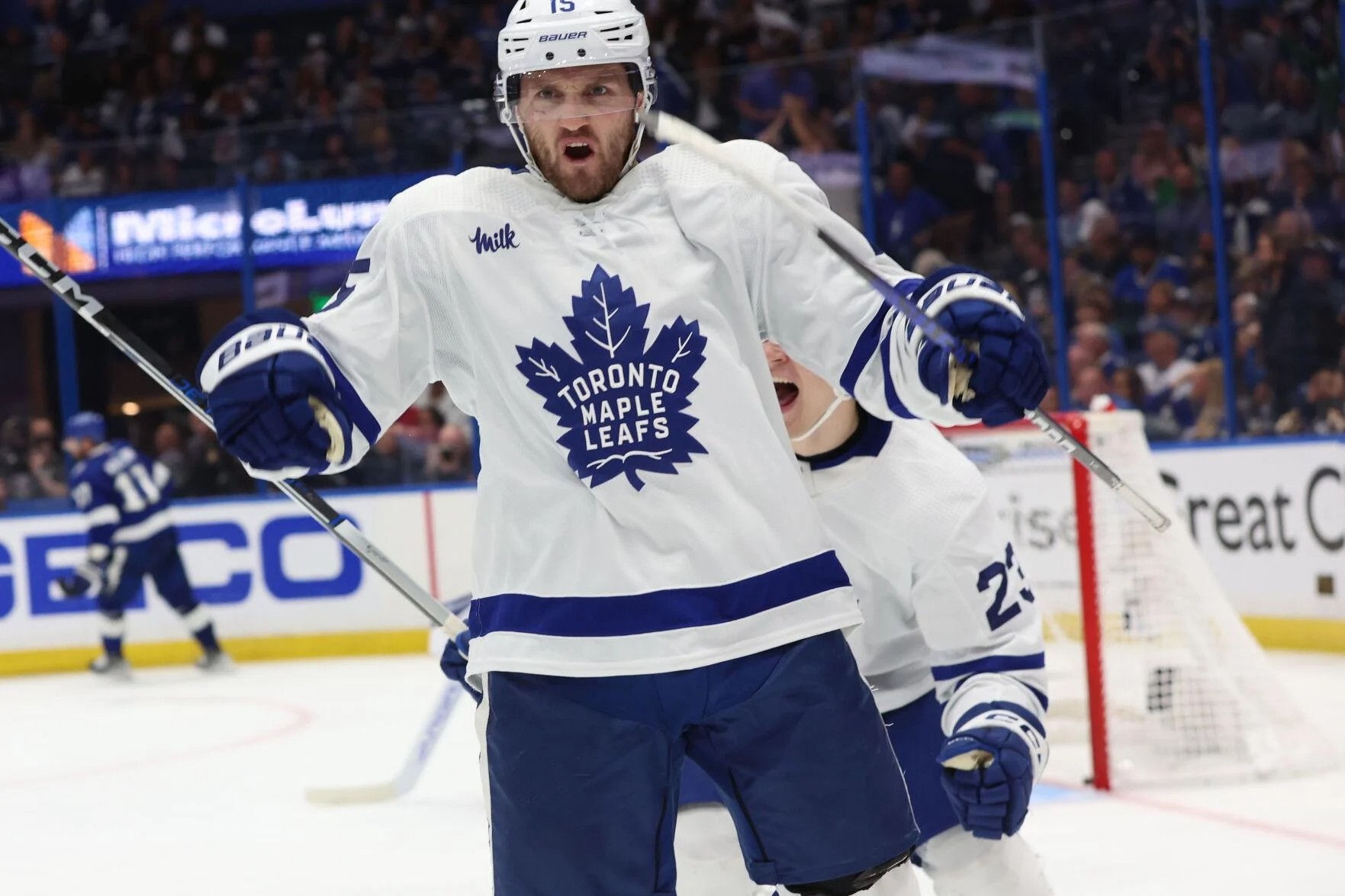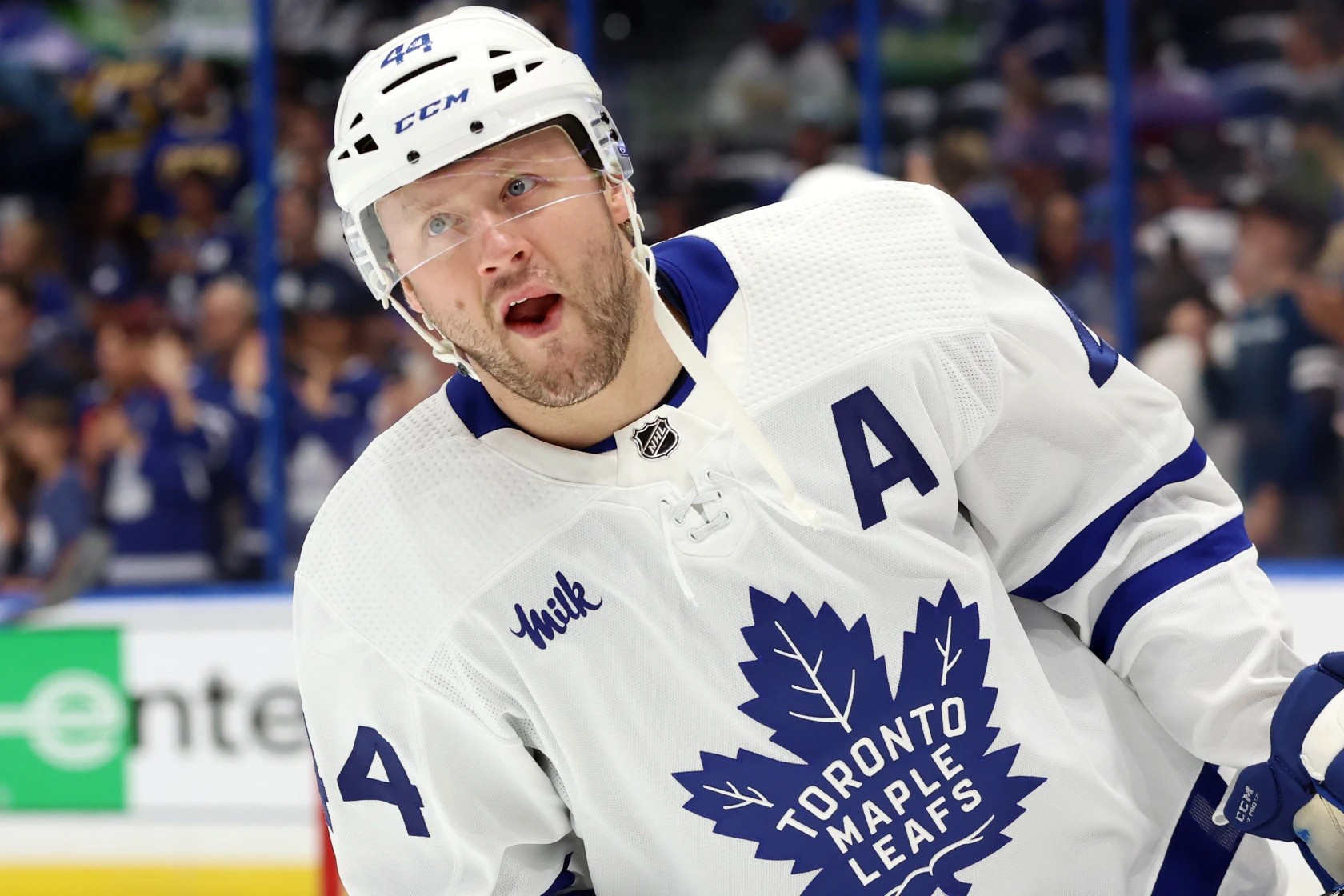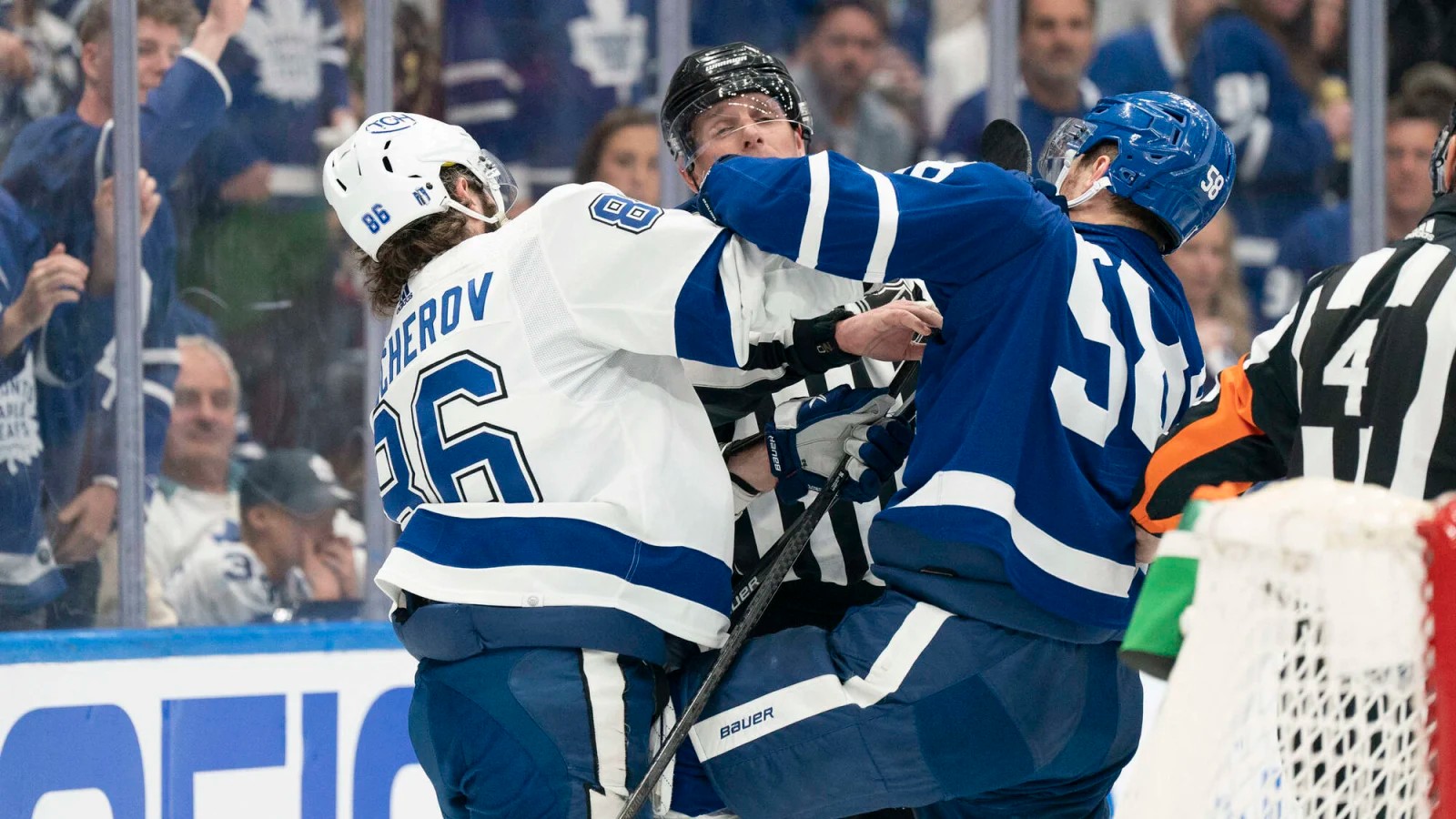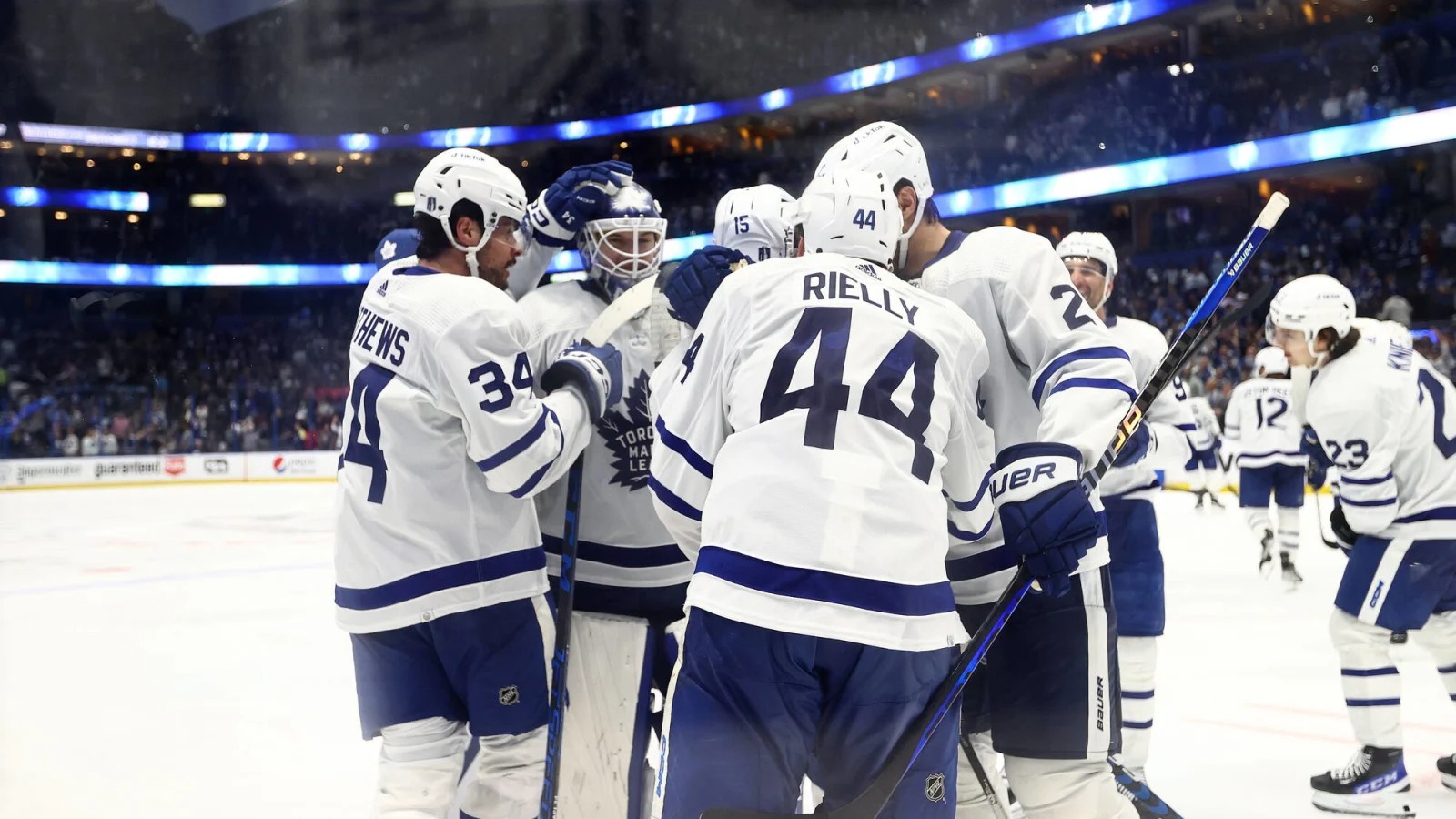Why win just one playoff road game in OT after a dramatic third-period comeback when you can win two in a row?
A team best known for being on the wrong end of playoff collapses, Toronto Maple Leafs just flipped the script in Game 4, rallying to win in a matter even more furious and unexpected than in Game 3. After trailing 4-1 with only 10:16 to go, the Leafs may have exorcised a playoff demon by scoring four times unanswered to tie it and then win the game in OT, with the heroic goal coming from who else but Alex Kerfoot, who deflected a shot by Mark Giordano on the PP.
The improbable comeback was complete and suddenly, in the most unlikely of fashions, the Leafs hold a commanding 3-1 series lead with a chance to close it out on Thursday night. It won’t be remembered this way unless the Leafs finally finish the job from here, but this has a real chance to stand up as one of the greatest victories in Leaf playoff history.
What did we learn in Game 4 and what does it mean for Game 5? Let’s break it all down.
Turning Points

There are three turning points in this game, and for the second straight game, #3 is an OT winner.
The first period was a pretty cohesive story and an inexplicable replay of Game 3 from the Leafs’ perspective. There were no tactical adjustments from Toronto. The lines were the same, and the schematic approach to the game was the same: passive in the neutral zone, timid in the offensive zone, defensemen not engaged in the offensive effort at all, and the defensive zone structure resembling a team defending a one-goal lead in the third period, not a team attacking a fresh game.
The Leafs again looked afraid of Tampa and got shellacked again, their fourth straight period of doing so. Down 2-0 after one, it was a continuation of where the previous game left off.
The second period began to shift for the Maple Leafs, but there was no main turning point here. Sheldon Keefe scrambled the lines, the defense began to activate more, and more pucks were put on net. At 5v5, the game was much more even, and the Leafs got one back.
As the period rolled along, Tampa grabbed a deflection goal via a shot from Victor Hedman off of Steven Stamkos’ skate and into the net, but it still felt like the Leafs could make up a two-goal deficit. That feeling vanished when the fourth goal went in — our first turning point.
In the period of the long change, as Toronto tried to sneak Mark Giordano and Justin Holl onto the ice, it led to a 2v2 into the defensive zone. Alex Killorn held the puck while Brandon Hagel went to the net. Giordano gave Killorn too much space to rip the puck, and Holl tried to clear Hagel out from in front but was unable to by the time the shot was taken. Ilya Samsonov had little chance as the shot clanged off the post and in, making it 4-1 Lightning with 1:11 left in the second.
That turning point appeared to put the game away; it just wasn’t Toronto’s night. While many were furious during the second intermission, the Leafs played a better period and weren’t rewarded. The underlying numbers at 5v5 concurred, drawing even in scoring and high-danger chances.
The issue was the unacceptable first period. That was set to be the narrative of the game and consume the vast majority of the coverage when Toronto trailed 4-1.
But then turning point #2 arrived — the PPG that closed the gap to 4-3. The Leafs had been rather subdued for the first half of the third period, looking for some kind of spark to seize on (if not to win the game then to at least give them something to build on for Game 5). Auston Matthews’ rush goal to cut the lead to two temporarily provided one, and not long afterward, a tripping penalty on Zach Bogosian really opened the doors. Score there, with nine minutes to go in the third, and we really have a hockey game. That’s exactly what happened.
The first 75 seconds of the PP were utter garbage — they were eaten alive by a new-look Tampa PK (more on that later) — before suddenly, the Leafs gained the zone one time, Nylander put a puck on net, and Matthews deflected it home. 4-3 with 7:31 remaining.
This was the true turning point. After this moment, the crowd went quiet and the Lightning were on their heels. Based on the way the teams played in the following few minutes, a game-tying goal felt inevitable. Toronto had all the momentum, and sure enough, Morgan Rielly, via a no-windup wrister off the point, found the back of the net for the equalizer with 3:56 to play.
That sent it to OT, where our final turning point arrived. The Leafs carried over all their momentum from regulation and continued to push play. Ilya Samsonov made one big save, and then William Nylander stepped up again in a key moment by drawing a penalty. The Leafs had their best-looking PP of the evening, generating a couple of looks with the top unit before the second unit jumped on.
Nylander gained the zone, and Mark Giordano picked up the puck at the point. The veteran defenseman one-touched it to settle the puck down and then floated a shot toward the net. Alex Kerfoot, posting up in front of Andrei Vasilevskiy, deflected the puck in and completed a truly stunning Leaf playoff comeback.
Notable Performances

Let’s start with the OT hero, Alex Kerfoot. Kerfoot scored one goal over 34 games spanning from the end of December to the third week of March, shooting 2.2% in that span. He did notch three in the final 12 to close the season and then scored the biggest goal of his career in Game 4 OT, his first point in the series.
Kerfoot’s game was a story of redemption with a giveaway in the first period that led to a goal for Tampa and then three huge events late in the game to pull off the win. Kerfoot was tripped by Zach Bogosian, drawing the PP opportunity leading to the 4-3 goal. He also chased down Ross Colton in OT on the backcheck, nullifying a possible rush chance for the Lightning. He then scored the winner on a deflection.
If the Maple Leafs can finish this series off, Kerfoot will have written his name into franchise lore with this goal.
Auston Matthews is next up with a pair of goals to bring the Leafs back from three down to one down. One came on a powerful release where he just needed to hit the target and the other one came on another deflection, AM34’s second such goal in this series. Matthews’ third period was what a superstar is supposed to do, and it was a statement moment in the history of his Maple Leaf career. Now he needs one more…
Mitch Marner had one of those odd games where he didn’t seem terribly noticeable yet ended the game with three assists. It was Marner who whipped the pass across to Matthews for his first goal, and he made a magnificent play to get the puck off the wall while retaining possession on the game-tying goal. #16 also picked up a secondary assist on the Matthews PP tally, and he now has eight assists and 10 points for the series, leading the NHL in postseason scoring.
William Nylander played another up-and-down game contrasting the two ends of the ice. There was a half-hearted shot block attempt on the second Tampa goal and a horrendous offensive-zone tripping penalty in the first period, which the Lightning capitalized on.
Nylander was absent offensively for the first two periods, but he ended up picking up three assists during the comeback: a secondary assist on the first Matthews goal, a primary one on the Matthews PP deflection, and a secondary assist on the Kerfoot winner (a play he led the entry on) after drawing the penalty. I’d like to see Nylander more locked in and engaged across all 200 feet over the 60+ minutes, but it’s hard to argue he isn’t contributing offensively when he boasts seven points for the series.
The best forward for Toronto over the first two periods was Ryan O’Reilly, whose strip of Nikita Kucherov created the first Leaf goal. ROR also had a chance to win it in OT. He remains a detail-oriented, hard-working model of consistency on every shift.
ROR’s linemates entering the game (it was scrambled some in-game), Noel Acciari and Matthew Knies, both contributed in big ways. Acciari scored another goal — this time on a deflection off a point shot — while Knies saved a goal by yanking a puck right off the red line and playing it with his stick between his own legs to keep it out. Noteworthy: Knies has also been on the ice for both OT winners in this series.
Morgan Rielly scored his second consecutive massive goal, threading a wrist shot through traffic to tie the Game at 4. Rielly and his partner Luke Schenn were Toronto’s two best forwards in expected goals and high-danger chances.
This has been the team’s best defensive pair at this point in the series. They seem to have developed chemistry and confidence under pressure that was not there in the regular season. Rielly, who now has six points in the playoffs, is the top-graded defenseman *in the entire league* this playoffs according to the advanced metric GSVA (read more from The Athletic‘s Dom Luczyszyn). Playoff Rielly is real, and after not finishing as the highest TOI defenseman in Game 3, Rielly played nearly five minutes more than any other Leafs defenseman in Game 4. I’d expect that to continue moving forward.
After a dominant Game 2, captain John Tavares was largely absent for Games 3 and 4 in Tampa, providing a nice screen for Rielly’s game-tying goal but not creating a ton else. His faceoff presence helped in this game, but the Leafs need more out of him. The early returns when they switched to Marner/Tavares were much better for #91 (to no one’s surprise), so perhaps another game with Marner in Game 5 can lead to another strong Tavares effort in front of the home crowd.
The fourth line of David Kämpf, Zach Aston-Reese, and Sam Lafferty wasn’t a standout, generating little offense again and losing their minutes, but that line has not had a single offensive-zone start in this series, with the vast majority coming in the defensive zone. Their deployment — and the fact that despite the losing minutes they are only -1 for the series in goals at 5v5 — has helped the Leafs win games by freeing up their top lines for more advantageous matchups.
Meanwhile, on defense, things are still creaky outside of the Rielly pair. Mark Giordano and Justin Holl continue to struggle, something that your author attributes more to slippage in play from Giordano as its eerily similar to what happened last regular season when Jake Muzzin’s play started slipping… the pair’s results nosedive and Holl takes the brunt of the blame. Holl remains fabulous on the PK at shutting down the Stamkos one-timer, but he and his partner need to be better at 5v5.
The same could be said for TJ Brodie and Jake McCabe, who did play better as a duo in the back half of the game but need a cleaner outing overall. McCabe has been the best Leaf D besides Rielly at jumping up in the play, although blowing a tire late in the third did lead to a dangerous Tampa rush. McCabe had a look in OT to win it but put the shot wide. Brodie made a fabulous backhand pass to spring the Matthews rush goal, but he did nothing to stop the Kucherov pass to Killorn on the PK.
Finally, there’s Ilya Samsonov in net. The Toronto netminder did not grade out well in GSAx and his SV% doesn’t look pretty, but A) I don’t pin any Tampa goal on him, B) he made very timely saves to give the Leafs a chance, and C) he out-goalie’d Andrei Vasilevskiy yet again.
Of the four goals, I think you can say Samsonov might’ve been able to do a better job sliding over quicker on the Sergachev shot or maybe tried to fight to pick up the Killorn shot better, but in both cases, those were going to be extremely difficult saves. The other two goals he had no chance on.
Meanwhile, Samsonov stoned Brandon Hagel on a penalty shot in the first and made two vital, game-saving stops late: the save on Alex Killorn on the 3v2 after McCabe fell down, and then a point-blank stop on Steven Stamkos in the slot in OT when Tavares was caught sleeping.
Samsonov hasn’t been incredible, but he’s been solid since the G1 disaster and has come up with clutch saves in OT. That’s all the Leafs need when the goalie at the other end is struggling.
Storylines for Game 5

1. The tactical side. I was disappointed to see the Maple Leafs come out in Game 4 with no apparent changes to their tactical approach to the game. The lines were the same, problems breaking the puck out were the same, and the lax approach to the neutral zone and sustaining offensive-zone pressure was the same. It was frustrating, and it was going to be the story if the Leafs lost the game.
As the game went along, we saw the Maple Leafs start to figure it out. In the second period, their defensemen started to join the attack more and the Leafs were more aggressive in the defensive zone. That ramped up as the game went along, culminating in a dominant OT.
It is a little ridiculous that it’s taken this long, but hopefully, the Leafs have learned their lesson and will be ready from the jump of Game 5. There should be less of all five Toronto skaters collapsing to the slot in the DZ unless it’s late in the game and the Leafs have the lead. There should be more instances of their defensemen moving the puck up the ice offensively, joining the rush on occasion, and standing plays up at the blue line more aggressively. Dictate play and be the aggressor. Don’t play scared of Tampa to start the game. Play to win.
Likewise, adjustments will be needed on the PP. The Lightning surprised the Leafs with a tweak to their PK strategy, pressuring the drop-pass that the Leafs (and so many other teams) use to lead their entries on the man advantage. They also lined up their PKers at the blue line to choke off possession entries, which worked effectively. Tampa generated multiple shorthanded scoring opportunities, including the Hagel penalty shot.
The Leafs had one game to be surprised by it, and they can’t be on Thursday. Give Jon Cooper some credit for successful adjustments that have put the Lightning in a position to dictate play and play with a lead in these games, but the Leafs need to make a few of their own earlier in games rather than later.
2. Welcome back, Michael Bunting? Bunting returns from his three-game suspension in Game 5, giving Sheldon Keefe an interesting decision to make. There are clear risks in playing Bunting — the discipline component, most notably — but he is definitely one of the Leafs’ 12 best forwards even though he’s been scuffling down the stretch. Especially knowing the Leafs have not played their best hockey despite the positive results, I’m of the belief that Keefe should ice his best lineup, and that means Bunting jumps back in. But where?
A lot of it has to do with how the top six looks. The team looked far better with the new lines in the latter half of this game (unsurprising to many), so I would advocate for keeping Marner with Tavares and Nylander with Matthews — in which case, perhaps Bunting goes with 88/34 and Järnkrok with 16/91? Knies and Acciari would be back with O’Reilly, which means Kerfoot moves down to the fourth line with David Kämpf and then one of Aston-Reese and Lafferty comes out.
That’s one way to do it, but there are myriad other possibilities. It will be interesting to see what path Keefe takes.
3. What does Tampa have left in the tank? The Lightning played two (largely) great games in Tampa and yet they find themselves trailing 3-1 in a series where they’ve been the better team for roughly eight or nine of 13 full periods. How demoralized are they? How much gas do they have in the tank?
Jon Cooper has adjusted well but hasn’t been rewarded. You have to think that the Lightning spent many of the hours following Game 4 wondering, “How the hell did this happen?” A game that was a sure thing slipped away, and suddenly the series is totally different.
For most all teams, I would predict said team blowing the lead to come out completely flat and dazed in Game 5. But the Lightning are champions, with a hyper-competitive core of players. They dug deep in Game 4 after a deflating Game 3. Now they have to dig even deeper — not just to win this game, but to win three in a row.
It’s a difficult climb they’re facing, but I don’t expect them to give up. That said, the Bolts did look fatigued late in Game 4, and if the Leafs can come out strong in Game 5, maybe they can bury them early and break their resolve.
4. Andrei Vasilevskiy. The play of the vaunted Lightning goalie has become a massive storyline in this series — and rightfully so. After a very poor showing in Game 3, Vasilevskiy gave up five more goals. None of them were howlers, but we seem to have discovered an Achilles heel: the screened point shot.
It feels like nearly every seeing-eye shot that makes it through the mass of bodies is beating Vasilevskiy right now, and his results for the series are ugly: .856 SV% and -5.51 GSAx, per Evolving Hockey. That SV% is actually identical to his clip in the four-game meltdown against Columbus back in 2019, so we have seen this Vasilevskiy before. It’s just there was so much playoff success in between that it has made this seem implausible.
Vasilevskiy seems lost right now in net and is not tracking point shots well at all. I wrote in this very space last year after Game 1 that when I went back and examined the game tape from the Columbus 2019 series, a disproportionate number of goals allowed by Vasilevskiy seemed to come from the point through traffic. The Lightning were well aware of that weakness — per Derek Lalonde’s comments on the Sportsnet panel on Monday night — and now the Leafs seem to be exploiting it.
Even beyond this series, Vasilevskiy finished the regular season with a very pedestrian .904 SV% from March 1 onwards. If you add the playoffs to that, he has a .893 SV% (-3.01 GSAx) in his last 19 games. Vasilevskiy will always have his accomplishments to his name, but right now, goaltending has to be the #1 area for concern for Jon Cooper coming into Game 5. A turn-around in Vasilevskiy’s play is also probably their biggest path to winning this series now.
5. Closing it out. Well, here we go again. Another chance to finally get over the hump. This group had one crack in 2018, two cracks in 2019, one crack in 2020, three cracks in 2021, and two cracks in 2022. That’s 0/9. Now they get three more, and Game 5 is the first swing at it. It’s also the most pivotal.
The Tampa Bay Lightning are a good home team, even if they were unable to grab either game. No one will be happy about having to go back to Tampa for Game 6 on Saturday. End it on Thursday. The Leafs will be in the friendly confines of Scotiabank Arena with a rocking crowd behind them and everyone in Leafs Nation begging for the drought to end at home. Sheldon Keefe will also have the last change at his disposal. Don’t give them any rope.
The biggest storyline in all of those potential clinching games is how the Leafs so rarely own the lead and even more rarely score first. They scored first in 2018 Game 7 and held a lead for ~20 minutes in that game total. They also scored first in 2019’s Game 6 (a lead they held for ~1.5 minutes), but amazingly, they have not scored first in a single potential clinching game since. Their next lead in such a game after that 2019 game was last year’s Game 6, a lead they held for only 9.5 minutes.
The best way to finally get it done is to flip the script by scoring early, holding a lead, defending well, and pouring it on. No one wants to see this series go back to Tampa, and no one wants to even think about another Game 7. Play your best game of the series and finally end this misery.






























![New Leaf Anthony Stolarz on the opportunity in Toronto: “In Florida, I knew my role as a backup… Now, [Joseph Woll] and I are competing for starts… As a goalie, that’s all you can ask for” Anthony Stolarz, Stanley Cup win, now Maple Leaf](https://mapleleafshotstove.com/wp-content/uploads/2024/07/anthony-stolarz-sc-100x70.jpg)
